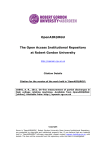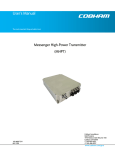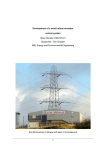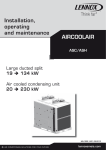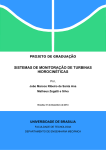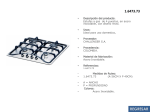Download - Murdoch Research Repository
Transcript
March 4, 2013 Motor Generator Dynamometer Setup Presented By Michael D'Uva Supervisor: Graeme Cole 2 Abstract The primary aim of this thesis was the further development and reconstruction of the Motor Generator Dynamometer set up. Once completed, the apparatus is to be used as a learning tool for the engineering students at Murdoch University, demonstrating key concepts of electric machines and their reactions to the change in load conditions. For the mention primary aim the design, construction and commissioning of a load bank had to be adapted to the initial setup to enable the students to alter the connected load. Measurements and control of the apparatus was achieved through National instruments NI 6014 data acquisition unit and National Instruments LabVIEW. The understanding of the project and the work that had been previously completed was the first stage of the project. Understanding the current system setup including the: •
DAQ system •
AC motor •
DC Generator The resolution of existing problems was attempted such as overcoming the interference induced by the variable Frequency drive, accurate speed measurement of the machines and calibration of the torque measurement. As the main priority associated with the development of this project was safety for undergraduate students to perform experiments without the risk of being injured. This is why a complete reconstruction of the set up must take place further information can be found in the guidelines and design approaches that have been developed. 3 4 ACKNOWLEDGMENTS .............................................................................................................. 10 1 INTRODUCTION .................................................................................................................. 11 1.1 KEY OBJECTIVES OF THESIS ........................................................................................................... 11 1.2 THESIS OUTLINE .............................................................................................................................. 11 2 BACKGROUND ..................................................................................................................... 12 2.1.1 Motor Generator ...................................................................................................................... 12 2.1.2 Dynamometer ............................................................................................................................ 13 2.1.3 3 Phase Induction Motor ...................................................................................................... 13 2.1.4 Variable Frequency Drive .................................................................................................... 14 2.1.5 Generator Theory .................................................................................................................... 16 2.1.5.1 DC Generators .................................................................................................................................................. 17 2.1.6 Load Cell ...................................................................................................................................... 24 2.1.7 Data Acquisition ....................................................................................................................... 25 3 EXISTING SET UP ................................................................................................................ 28 3.1 OVERVIEW ......................................................................................................................................... 28 3.2 KNOWN PROBLEMS WITH THE SET UP ......................................................................................... 40 3.2.1 Calibration of the torque ...................................................................................................... 40 3.2.2 Speed detection ......................................................................................................................... 40 3.2.3 Interference ................................................................................................................................ 40 3.2.4 Loading of the DC generator .............................................................................................. 41 3.2.5 Knowledge of the DC generator ........................................................................................ 41 4 RECTIFYING THE ISSUES .................................................................................................. 42 4.1.1 DC Generator ............................................................................................................................. 42 4.2 SPEED DETECTION ........................................................................................................................... 43 4.3 INTERFERENCE ................................................................................................................................. 46 4.4 LOAD BANK DESIGN ......................................................................................................................... 48 5 SUMMARY AND FUTURE WORK .................................................................................... 51 5 6 BIBLIOGRAPHY ................................................................................................................... 54 6 FIGURES Figure 1: Motor Generator Setup (Whitaker 2007) .............................................................................. 12 Figure 2: Rotation of the magnetic field in an induction motor ...................................................... 13 Figure 3: Torque-‐speed curve of an induction motor (Svjo 2012) ................................................ 14 Figure 4: Voltage / Frequency ratio ............................................................................................................ 15 Figure 5: Basic 3 phase PWM drive components (Cowie 2007) ..................................................... 16 Figure 6: Output voltage of an elementary generator during one revolution (Bhatia 2010)
............................................................................................................................................................................ 17 Figure 7: The elementary generator (Bhatia 2010) ............................................................................. 18 Figure 8: Effects of commutation (Bhatia 2010) .................................................................................. 18 Figure 9: Effects of additional coil (Bhatia 2010) .................................................................................. 19 Figure 10: Brushes shorting commutator segments (Bhatia 2010) .............................................. 19 Figure 11: Armature reaction (Bhatia 2010) .......................................................................................... 20 Figure 12: Compensating windings and interpoles (Bhatia 2010) ................................................ 20 Figure 13: Simplified circuit of a separately excited DC generator (Chapman 2012, 531) . 21 Figure 14: Terminal characteristics of a separately excited DC generator ................................ 22 Figure 15: Equivalent circuit of shunt DC generator (Chapman 2012, 535) ............................. 23 Figure 16: Voltage build up of self-‐excited generator (Chapman 2012, 536) ........................... 23 Figure 17: Terminal characteristics of a self-‐excited generator (Chapman 2012, 538) ....... 24 7 Figure 18: Resistive bonded foil strain gauge (left) (AnonMoos 2012) Wheatstone bridge configuration (right) (Rhdv 2007) ..................................................................................................... 24 Figure 19: General arrangement of data acquisition (Peter Tavner 2008, 104)Proximity sensor .............................................................................................................................................................. 26 Figure 20: Sensors four main elements ..................................................................................................... 26 Figure 21: Proximity sensor inducing eddy currents .......................................................................... 26 Figure 22: Affect of metal object on oscillator ........................................................................................ 27 Figure 24: Allen Bradley variable frequency drive ............................................................................... 29 Figure 25: Proximity sensor for speed measurement (Jack Neylan 2013) ................................ 30 Figure 26: Dynamometer set up ................................................................................................................... 31 Figure 27: Current shunt used to measure current .............................................................................. 31 Figure 29: Dataforth Board with 4 Blocks ................................................................................................ 34 Figure 30: Front panel of LabVIEW program .......................................................................................... 35 Figure 31: Block diagram of the LabVIEW program ............................................................................ 35 Figure 32: VSD frequency scaling and protection ................................................................................. 36 Figure 33: Block diagram of proximity sensor counter ...................................................................... 38 Figure 34: Code for preparing data for logging ...................................................................................... 38 Figure 35: Program for assigning spreadsheets column headings, time and date ................. 39 Figure 36: Program for logging data to Excel and popping up on completion ......................... 39 Figure 37: Self-‐excited shunt generator configuration ....................................................................... 43 8 Figure 38: LabVIEW Speed detection program ...................................................................................... 44 Figure 39: Noise from teeth of encoder wheel ....................................................................................... 45 Figure 40: Proximity sensor logic wiring configuration ..................................................................... 45 Figure 42: DC load bank configuration ...................................................................................................... 50 Figure 43: Switching between excitation topologies ........................................................................... 53 Figure 44: VFD pin out ...................................................................................................................................... 57 Figure 45: Overall wiring configuration .................................................................................................... 58 Figure 46: Field terminal box wiring configuration ............................................................................. 58 Figure 47: Switchboard wiring configuration ......................................................................................... 59 9 Acknowledgments I would like to thank my academic supervisor Associate Professor Graeme Cole, for his guidance and advice throughout my thesis project. I would also like to thank the Murdoch university technical staff of John Boulton, and Iafeta ‘Jeff’ Laava. I am very grateful for their constant assistance in the technical development of my thesis project. I would also like to thank my mum for her constant support and motivation during my thesis project. 10 1 Introduction The project involves the further development and reconstruction of the motor generator dynamometer set up located in Murdoch University’s pilot plant. The project has been a continuation of the project started in ENG 454. The apparatus is designed to be an educational tool for the engineering students at Murdoch University, to perform experiments and testing scenarios in a safe and risk free learning environment. At this stage the main task of the project was to design, set up and commission a programmable electrical load for the system. Explained in more detail in a later chapter, the project essentially consists of an induction motor controlled by a VFD that is being utilized as prime mover for a dc generator. The measurements and control of the set up is through a data acquisition system. 1.1 Key Objectives of Thesis The key objectives of the thesis project included: •
Understand the fundamental workings of the existing system such as the motor generator set up, data acquisition and Variable Frequency Drive (VFD). •
Implement a shaft speed measurement which is able to read the rotational speed of the motor generator •
Remove existing noise that is effecting measurement signals •
Calibration of the torque measurement •
Design, construct and commission a DC load bank •
Reconstruction of the overall set up taking into account good wiring and layout practices 1.2 Thesis Outline The thesis itself is broken into 5 separate chapters these include: Chapter 2: this chapter provides the reader with the background and theory behind the devices that have been utilized in this project. 11 Chapter 3: the chapter gives an overview of the existing system and the issues that need to be resolved to allow the project to be further developed. Chapter 4: this chapter outlines the methods that were used in an attempt to resolve each of the preexisting problems. Chapter 5: the final chapter summarizes the results, the achievements and the future recommendations for the project. 2 Background This chapter gives the reader an in depth understanding of the components used in this set up. Explaining the theoretical knowledge needed to understand the devices capabilities and functionality. 2.1.1 Motor Generator A motor-‐generator refers to a device comprised of a motor that has been mechanically coupled to a generator this is shown below in Figure 1. The main purposes of this device are to convert electrical power from one form to another and to test the performance of the device, this will be explained later on. One of the most important design elements in a motor generator setup is the prime mover. When using DC motor drives the speed can be controlled independent from the frequency of the power supply. In the past this use to be a major advantage over the simpler and less expensive induction motor. Due to the development of Variable speed drives the speed of an induction motor can now easily altered. The induction motor in this setup is known as the prime mover. Motor Generator Figure 1: Motor Generator Setup (Whitaker 2007) 12 2.1.2 Dynamometer A dynamometer is basically a torque-‐measuring device, which measures the rotating force produced by a rotational shaft. It works by allowing the stator to rotate freely with the armature shaft fixed within a ball bearing housing, holding the generator in place. Connected to the yoke of the generator is a load cell, which allows the torque measurement to be acquired and prevents the stator to spin around uncontrollably. As the generator is placed under load, the stator will have the desire to rotate, placing strain on the load cell. The signal measured from the load cell allows the amount of torque that is being developed by the generator, to be calculated. 2.1.3 3 Phase Induction Motor Three-‐phase induction motors popularity in the industry can be accredited to its cheap and robust construction and the convenience of available three phase power supplies. The induction motor operates by currents flowing in the stator windings creating a magnetic field rotating around at synchronous speed. The synchronous speed !! =
!"#×!
!
can be calculated from the frequency of the supply f and the total number of pole-‐pairs p that are arranged in the three phase stator windings (M. A. Laughton 2003). As the field rotates around the stator the shorted rotor conductors cut the field inducing an emf and causing currents to flow. As the current flows in the rotor it creates its own magnetic field that interacts with the main field. The interaction between these two fields produces a torque causing the rotor to spin in the direction of the main field this is shown below in Figure 2. Figure 2: Rotation of the magnetic field in an induction motor 13 For an induction motor the rotor generally rotates at a slower rate then the synchronous speed, this is characterized by something called the slip. The magnitude of the currents produced in the rotor depends on this slip and rotor winding impedance. The slip ! =
!! !!
!!
, is the variance between the synchronous speed ns and the rotor’s actual speed of rotation n. If the rotor rotates at synchronous speed the corresponding slip is zero. This causes the induced emf to be zero, consequently no rotor current or torque is produced. The synchronous speed cannot be achieved due to the small amount of torque that is needed to overcome the mechanical losses in the motor. As load is placed on the motor it causes the motor to slow down in turn producing a larger slip, which causes rotor emf to develop, and currents to flow this in shown in Figure 3. Figure 3: Torque-‐speed curve of an induction motor (Svjo 2012) 2.1.4 Variable Frequency Drive A Variable Frequency Drive (VFD) also known, as a Variable Speed Drive (VSD) is an electronic controller used in industry for speed control of AC induction motors both single and three phase. As the speed of the motor is altered, this device allows the power consumption, torque, impedance and many more desired functions to remain the same. As discussed previously there are two factors that determine the speed of an AC induction motor. These are the number of stator poles and the supply voltage frequency. Therefore to enable the speed to be altered either one of these factors must be changed. 14 Since the number of stator poles is fixed at construction, the only possibility is varying the supply frequency to change the motor speed. However when the frequency is altered while the voltage is kept constant, the equivalent impedance of the motor decreases. As this happens it results in the change of the magnetic flux in the motor, causing it to draw extremely large currents. To overcome this issue it is imperative that the supply voltage and the frequency are altered proportionately in a fixed ratio. This also ensures that the magnetic field in the air gaps is constant resulting in constant torque delivered by the motor. Figure 4 demonstrates the motor running at normal operating conditions, with the slope being proportional to the torque. It can be seen that the required ratio needed is around 7.67 volts per hertz. As the voltage is altered to 230 volts so the slope changes thus causing a drop in torque. To enable the torque to remain constant, the required frequency is 30 Hertz. Figure 4: Voltage / Frequency ratio An electronic circuit of a VFD unit is shown in figure 5. It can be divided into three main stages. These are the input Rectifier circuit, Fixed DC voltage and the inverter circuit. 15 Figure 5: Basic 3 phase PWM drive components (Cowie 2007) The first stage of the VFD is the rectifier circuit. This is where the AC supply is rectified into DC. It is accomplished by using 6 high-‐powered diodes arranged into a three-‐phase bridge rectifier to produce a rippled DC supply. To produce a clean DC supply inductors and capacitors are used as filters removing the unwanted ripple effect caused by the rectifier. The last stage of the process is the inverter circuit. As the name indicates it inverters the DC supply. To produce the desired sinusoidal output this stage switches Insulated Gate Bipolar Transistors (IGBTs) creating pulse width modulation. By changing the switching rate and the duration of the pulses the voltage and frequency can be simultaneously controlled while keeping the desired torque and magnetic flux constant. 2.1.5 Generator Theory In the production of electricity, a generator is used to convert mechanical energy to electrical energy. This transformation is referred to as electromechanical conversion and is produced via electromagnetic induction. There are two types of electrical generation, direct current (DC) and alternating current (AC). Both types of generators use the same concept, discovered many years ago, known now as Faraday’s law of induction. This describes the phenomenon that if there is a variation in the magnetic environment of a coil of wire, in turn a voltage (emf) will be produced in that coil. Both machines generate an AC voltage and currents. The DC generator outputs DC due to a mechanism called a commutator, which will be explained later. As the project only deals with DC generation no further information on AC will be discussed. 16 2.1.5.1 DC Generators DC generators are DC machines that are configured to convert mechanical energy to electrical energy. A DC machine can be either run as a generator or a motor. Physically they are the same, it is simply the configuration of the set up. All generators are driven by prime movers, the mechanical source that rotates the armature. The prime mover can be steam turbines, a diesel engine, or even an electric motor. DC generators are quite rare in modern power systems. Even DC power systems such as those in automobiles now use AC generator generally referred to as an alternator, with a rectifier to produce DC power (Chapman 2012). Discussed previously, Faradays law of induction stated if you changed the magnetic environment of a coil a voltage will be induced into the coil. One method of changing the magnetic environment, is to have motion of the coil relative to the magnet. This is the basic principle that a generator uses when generating electricity it spins a coil known as the armature around in between two magnets cutting the lines of force. The three main factors that determine the amount of voltage generated are: •
The number of conductors in the armature (Hand 2011) •
The number of magnetic lines of force (or flux) from the stator (Hand 2011) •
The speed at which the armature conductors cut or are cut by the lines of force (Hand 2011) The illustration in Figure 6 shows the output voltage when the armature (in this case a simple loop of wire) is rotated in between the stator (shown as a stationary magnetic field). Image has been removed due to copyright reason please refer to website https://www.cedengineering.com/upload/DC%20Generators%20and%20Motors.pdf Figure 6: Output voltage of an elementary generator during one revolution (Bhatia 2010) 17 The illustration demonstrates that as the wire rotates an AC voltage is generated. As in a real generator the magnetic field is concentrated as close as possible to the wire. The positioning and shape of the pole pieces achieves this result. To allow the armature loop to rotate slip rings are added the ends of the loop. They rotate with the armature and brushes are used to slide along the rings allowing the generated voltage to be accessed. Image has been removed due to copyright reason please refer to website https://www.cedengineering.com/upload/DC%20Generators%20and%20Motors.pdf Figure 7: The elementary generator (Bhatia 2010) The poles above in Figure 7 are shown as permanent magnets, but can also be electromagnets. To generate the magnetic field, copper wire is wound around iron cores, which are attached to the generators stator. The main advantage of utilizing the electromagnetic poles is that the field strength is increased and the strength of the field produced can be controlled. By varying the voltage that is fed into the field windings the field strength can be varied this allowing control of the output voltage seen at the generator terminals. To produce DC a device called a commutator must replace the slip rings. The commutator works by mechanically reversing the armatures connections to the brushes, altering the AC voltage into a pulsating DC voltage as can be seen in Figure 8 below. Image has been removed due to copyright reason please refer to website https://www.cedengineering.com/upload/DC%20Generators%20and%20Motors.pdf Figure 8: Effects of commutation (Bhatia 2010) To produce a smoother output voltage with less ripples practical DC generators increase the number of armature loops and commutator segments. Illustrated in Figure 9 is the effect of when one extra coil is added compared to the single coil shown in Figure 8. 18 Image has been removed due to copyright reason please refer to website https://www.cedengineering.com/upload/DC%20Generators%20and%20Motors.pdf Figure 9: Effects of additional coil (Bhatia 2010) In the design and production of DC machines great care is taken to ensure that there is a magnetic balance of the poles. This is achieved by placing the poles at equal distances around the stator with each having an identical number of turns guaranteeing that the magnetic field strength is produced. The instances that the voltage polarity in the armature loop reverses, the armature connections to the brushes are mechanically reversed. This is how commutation is achieved. As the brushes moves along the commutator insulated segments are briefly shorted. To compensate for this occurrence the brushes are located in the neutral plane. The neutral plane is where the coils in the armature run parallel with the line of flux made by the stator. Because no lines are being cut there is no voltage being generated, therefore making it possible for the segments to be shorted. This is illustrated in Figure 10. Image has been removed due to copyright reason please refer to website https://www.cedengineering.com/upload/DC%20Generators%20and%20Motors.pdf Figure 10: Brushes shorting commutator segments (Bhatia 2010) As a voltage is generated in the armature, current flows through the coils producing its own magnetic field. The magnetic field that is created distorts the already existing main field that is created by the poles, in turn prompting a change in the neutral plane. As the neutral plane shifts, it makes the brush location not suitable for commutation, as now there is a voltage being induced in the coils. This shift in the neutral plane is due to the created magnetic field in the armature windings this is called armature reaction. In Section A of Figure 11 the main magnetic field is shown undistorted without the armature inside the stator. Current flowing through a single coil representing the armature is shown in Section B. The arrow indicates the current is flowing into the page 19 and the dot indicates the current is flowing out. Around the armature wires a magnetic field is created, this field’s strength increases with each additional wire within the armature’s coil. Section C demonstrates how the main field is distorted, which causes the neutral plane to move from its original position. Image has been removed due to copyright reason please refer to website https://www.cedengineering.com/upload/DC%20Generators%20and%20Motors.pdf Figure 11: Armature reaction (Bhatia 2010) To rectify this problem the brushes can be manually realigned with the new neutral plane. But as the load is varied on the generator, the current being drawn through the armature coils varies. With the magnitude of the current being proportional to the magnetic field created around the coil, as the current changes so does the magnetic field. This will affect the armature reaction causing the neutral plane to be relocated. Due to the armature reaction being effected by the load current variations, the brushes would have to be constantly realigned. This solution is only practiced in the small generators, as with the larger generators extra windings are adopted to resolve the problem. The extra windings that are utilized to resolve the problem of the armature reaction are either compensating windings or interpoles. The compensating windings are rooted in the pole faces, where the interpoles are placed between the main field poles this is illustrated in Figure 12. In both cases the winding are connected in series with the armature so as the armature’s current varies so does the current in the additional windings. The magnetic field that is created by the additional windings cancels the effects of the armature reaction. This enables the neutral plane to continue in its original position. Image has been removed due to copyright reason please refer to website https://www.cedengineering.com/upload/DC%20Generators%20and%20Motors.pdf Figure 12: Compensating windings and interpoles (Bhatia 2010) 20 There are five major types of DC generators, classified according to the manner in which their field flux is produced: (Chapman 2012) 1. Separately excited generator 2. Shunt generator 3. Series generator 4. Cumulatively compounded generator 5. Differently compounded generator These generators all have different terminal characteristic, therefore they all have specific situation for when they are best suited. This depends on the voltages, power ratings, efficiencies and voltage regulations. (Chapman 2012) !" =
!!" − !!"
× 100% !!"
The voltage regulation (VR) is rough measure of the generators voltage current regulation. Vnl is the no load terminal voltage where Vfl is the full load terminal voltage. In this document only the shunt generator will be covered due its relevance in this thesis. A shunt generator can be broken into two categories a self-‐excited or a separately excited. A separately excited generator is identified when the field current is being supplied by an external DC source. Figure 13 illustrates the generator configuration. Image has been removed due to copyright reason please refer to Electric Machinery Fundamentals by Stephen J. Chapman Figure 13: Simplified circuit of a separately excited DC generator (Chapman 2012, 531) From figure 13, VT represents the voltage at the generator terminal and IL represents the line current that flows out the generator to the connected load Rload. In the separately excited generator the line current IL is equal to the armature current IA. EA is the internal 21 generated voltage of the generator, while VF is the applied voltage from the external DC source. By using Kirchhoff’s voltage law the generated voltage at the terminals can be determined. !! = !! − !! !! The terminal voltage seen on the separately excited generator is a straight line. This is due to IA having no effect on the internal generated voltage. As the load applied to the terminals increases, so does IL. As IL and IA are equal, the IARA drop increases making the terminal voltage of the generator to decrease. Figure 14: Terminal characteristics of a separately excited DC generator By controlling the internal generated voltage EA, manipulation of the generators terminal voltage is possible. With EA = !∅!! thus there are two ways of changing EA, the speed of rotation !! or changing the field current, consequently changing the flux ∅. Commonly the field current is controlled, because in most cases the margin of the speed adjustment is minimal. A self-‐excited shunt DC generator on the other hand generates its own field current by connecting its field winding across its terminals. The distinct advantage of this generator over the separately excited one is that it does not need an external power supply. Unlike 22 the self-‐excited the armature current supplies both the field and load current IA = IF + IL, as can be seen in Figure 15. Image has been removed due to copyright reason please refer to Electric Machinery Fundamentals by Stephen J. Chapman Figure 15: Equivalent circuit of shunt DC generator (Chapman 2012, 535) To allow the generator to generates it own field current, a residual flux in the poles must exist. As the generator begins to turn an internal voltage is generated, which is given by !! = !∅!"# !! The voltage generated may be minimal around 1 to 2 volts but enough to cause the current to flow in the field windings. With the current increasing it causes the flux produced by the windings to increase as well. As the flux increases, more voltage is generated !! = !∅!! , which in turn increases the terminal voltage. This process keeps repeating until eventually the terminal voltage is limited by the effect of magnetic saturation in the pole faces. This can be seen in Figure 16. Image has been removed due to copyright reason please refer to Electric Machinery Fundamentals by Stephen J. Chapman Figure 16: Voltage build up of self-‐excited generator (Chapman 2012, 536) The voltage seen at the terminals of a self-‐excited DC generator differs from that of the separately excited. This is due to the field current in the machine being dependent on its terminal voltage. For further explanation the generator has to be examined as the load is increased. As the load is increased, this causes IL to increase and so IA = IF + IL also increases. As in the separately excited the rise in IA causes a larger voltage drop across the armature resistance causing !! = !! − !! !! to decrease. 23 It’s at this stage that the two configurations differ. Unlike in the separately excited generator, the self excited has a decrease in VT, causing the field current in the machine to decrease, as a result the field flux to decreases. As the flux is decreased so is the internal generated voltage !! = !∅!! which further decreases the terminal voltage !! = !! −
!! !! . As can be seen below in Figure 17 there is a steeper drop off for the self-‐excited generator. Therefore there is poorer voltage regulation, then on the same piece of equipment that is separately excited. Image has been removed due to copyright reason please refer to Electric Machinery Fundamentals by Stephen J. Chapman Figure 17: Terminal characteristics of a self-‐excited generator (Chapman 2012, 538) 2.1.6 Load Cell A load cell is a sensor that converts a physical force into an electrical signal. The signal typically requires amplification before it can be a change in voltage, current or even frequency. Load cells are traditionally built using resistive bonded foil strain gauges. As the foil is distorted the resistance changes where it can be then measured defining the amount of strain that has been applied this is shown below in Figure 18. Figure 18: Resistive bonded foil strain gauge (left) (AnonMoos 2012) Wheatstone bridge configuration (right) (Rhdv 2007) Inside the load cell four individual strain gauges are configured into a Wheatstone bridge configuration as shown above in Figure 18. A voltage, typically 10 volts is applied to 24 the corners A and C of the Wheatstone bridge this is known as the “excitation voltage”. The configuration works by measuring the difference between corners D and B when the load cell is put under stress. With no load applied the output difference is close to zero because the resistor values are exceptionally close. As the force is applied the metallic members are stressed changing their resistance. A change in the resistance disturbs the balance of the bridge and creates a difference that is then measured. The difference produced is proportional to the force that has been applied. Amplification of this signal is usually required due to the signal being only in the millivolt range. 2.1.7 Data Acquisition The main purpose of data acquisition system is to measure real world physical conditions such as voltage and currents by sampling and converting the measurements into digital values that can be read into a computer. The basic elements that make up a complete data acquisition system are: •
Sensors and transducers •
Field wiring •
Signal conditioning •
DAQ hardware •
PC and DAQ software (with operating system) A basic analogue data acquisition system can be shown below in the Figure 19. The analogue DAQ hardware components can be broken into three main sections multiplexing, sampling and holding, and the analogue to digital conversion (ADC). The purpose of the multiplexing is to allow samples to be taken from multiple channels where one ADC processes it instead of having one for each channel. With a number of differnet of signals being sent to the data acqusition system the sample and hold function samples the signal and holds the value constant allowing better operation of the ADC. To enable the computer to read the data the analogue to digital converter reconstructs the signal into a digital format. 25 Image has been removed due to copyright reason please refer to Condition Monitoring of Rotating Electrical Machines by Peter Tavner, Li Ran, Jim Penman and Howard Sedding Figure 19: General arrangement of data acquisition (Peter Tavner 2008, 104)Proximity sensor A proximity sensor is a non-‐contact switch, which detects an object entering the near vicinity of the sensor. This means that the sensor does not have any moving part like a traditional limit switch and can be fully encapsulated, making it very robust to the environment. There are three main types of proximity sensors: inductive, capacitive and magnetic each having their own distinct purpose and properties. For this project an inductive proximity sensor is utilized. This type of sensor is comprised of four basic elements as shown in the Figure 20 (PEPPERL+FUCHS 30). Figure 20: Sensors four main elements The sensor creates an oscillating radio frequency radiated from the coil within the sensor. If a metallic object enters the path of the radiated field, this will cause eddy currents to be induced and circulate within the metal as shown below in the Figure 21. Figure 21: Proximity sensor inducing eddy currents 26 To maintain the eddy currents in the metallic object the oscillator requires more energy. So as the metallic object approaches the sensor it becomes a greater load on the oscillator until the load becomes too great, this can be seen in Figure 22. This causes the trigger circuit to acknowledge the state of the oscillator and switches, closing or opening the circuit depending on the switching configuration. (PEPPERL+FUCHS 30) Figure 22: Affect of metal object on oscillator 27 3 Existing set up This chapter gives an overview of the existing system and the issues that needed to be resolved to allow the project to be further developed. 3.1 Overview The motor generator dynamometer setup seen in Figure 23, is built on a large metal skid. Upon the flat bed of the skid the motor and generator are mechanically coupled. An upstanding backboard connected to the skid allows for the fixing of the control equipment and data acquisition system. The apparatus is controlled and measurements gathered by a local computer hosting LabVIEW. The project consists essentially of 3 main sections shown below in Figure 23; these are Section 1 the prime mover, Section 2 DC the generation and field measurements, and Section 3 the data acquisition and control. SECTION 3 SECTION 1 SECTION 2 VFD D
DAQ LOAD Figure 23: Basic project setup Section 1 is basically the speed measurement and prime mover of the motor generator set up. The prime mover consists of an AC motor, controlled by a variable frequency drive. The AC motor is a 3 phase 5 kW induction motor made by Baumuller Nurnberg (details are
shown in Table 1).
28 Table 1: Induction Motor Attributes Manufacturer: Baumuller Nurnberg
AC Induction Motor
3 Phase Type: DSV442 Volts: 440 Y connected Amps: 7.3 HP: 5 Duty: Cont. RPM: 1400 c/s (or Hz): 50 Secondary Volts: 150 Amps: 16 Class of insulation: E N. 639562 Controlling the induction motor is an Allen Bradley 1305 C, 415V, 3-‐Phase – 4kW, 318-‐
415V AC, 0-‐400Hz output variable frequency drive. The data acquisition card run by a local computer hosting a LabVIEW program that controls the speed setting of the VFD. This is achieved by sending a 0-‐10V analogue signal from the DAQ to pins 2 and 3 of the VFD. Two digital outputs of the DAQ are sent to pins 6 and 8, with 6 being the start button and 8 being the stop button to the VFD. As a safety aspect pins 11 and 12 are connected to a stop button mounted on the upright board. For further information on the VFD pin out see Appendix A. Figure 24: Allen Bradley variable frequency drive
To measure the speed of the set up an inductive solid-‐state proximity sensor manufactured by GO systems is installed. The proximity sensor is held in position by a fabricated bracket that is bolted to the side of the induction motor. Two metal tabs are 29 attached to the speed encoder wheel. As the tabs move past the proximity sensor it would create a pulse that would be read by the data acquisition system. The metal tab is shown in the Figure 25. Figure 25: Proximity sensor for speed measurement (Jack Neylan 2013) Section 2 consistes of the K.L. Electric Co Pty Ltd 5kw shunt DC generator, the dynamometer and field measurements. The generator is wired to be separately excited by having a separate power supply connected to the field windings. Table 2: DC Generator Attributes Manufacturer: K.L. Electric Co Pty Ltd
DC Generator
Output: 5 kW Type: ODX Volts (rated): 220 V Stator (rated): 22.75 HP: 5 Rating: Cont. RPM: 1450 Phase: DC Style: 537/46 Stator Conn: Shunt Inter Serial No: EI 2 30 The shaft of the generator is connected into the ball bearing housing of the dynamometer frame allowing the generator armature to rotate freely. The stator is connected to a metal leverage arm that is connected at one end to a load cell to measuring the force and in turn enabling the torque of the generator under load to be calculated. The set up is shown in Figure 26. Figure 26: Dynamometer set up
To measure the current that is being drawn by the load a current shunt has been utilized. A current shunt is a low resistance resistor that is used to calculate the current by measuring the voltage drop across the resistor. Because the resistance of the current shunt is so low it has a negligible impact on the circuit. The shunt is capable to with stand up 30A that is sufficient for these circumstances as the maximum current generated by the generator is 22.75A. With a resistance of approximately 0.01 ohms the measured voltage drop at 30A is 30 mV. The current shunt is placed in series with the load and the measurement wires across the resistor. The measurement wires are fed straight into a Dataforth module, which isolates, filters and scales the raw voltage. Voltage Drop Suppl
y Loa
d Figure 27: Current shunt used to measure current 31 Measurement of the generated voltage is essential in this project. This would allow students to monitor the voltage generated in the armature and field windings as the circumstances change. The voltage being generated can be up to 220v dc. This value is above the rated value for the DAQ. The largest Dataforth module available has a range from -‐40v to 40v. The implementation of two voltage dividers were needed, the first being the armature voltage and the second the field voltage. This is due to the range being considerably smaller then the generated voltage that can be produced. The voltage divider is comprised of a 68kΩ and a 10kΩ resistor in series this is illustrated in Figure 28. The voltage measurement is made across the 10kΩ resistor making the measured voltage 8 times smaller than the actual voltage. This voltage can then be sent to the Dataforth module and through to the DAQ are fed into the LabVIEW program to determine the actual voltage. Armature Voltage Field Voltage Figure 28: Voltage Divider Configuration Section 3 is the control center of the project, consisting of a National Instruments 6014 data acquisition system, controlling SSR’s and gathering measurements from the Dataforth modules. The LabVIEW programming environment is run on a local host computer, where all the measurements and control are coordinated. The analogue measurements made by the data acquisition card are limited to a 10V range and because of this fact the Dataforth modules have been employed. The 5B series Dataforth modules do not simply scale the analogue values they also provide isolation 32 from the field and filtering. With the isolation and filtering the Dataforth modules eliminate the interference induced in the signal cabling and remove the threat of having voltage spikes reaching the DAQ card. Four analogue signals utilize the modules these are measurements associated with the field voltage, armature voltage, the load cell and the current shunt. Each field signal is connected to an individual Dataforth block and the conditioned signal is fed to a corresponding channel of the terminal block. The four signal cables are wired to corresponding channels and a fifth is wired to the ground point as a reference for the NRSE configuration used by the DAQ card. The Dataforth blocks used for the corresponding signals are shown below. Field Voltage Dataforth Measurement Dataforth model: SCM5FB31-‐03, Isolated voltage input Input: -‐10V to 10V Output: -‐5V to 5V Armature Voltage Dataforth Measurement Dataforth model: Input: Output: SCM5B31-‐03, Isolated voltage input -‐10V to 10V -‐5V to 5V Current Shunt Voltage Dataforth Measurement Dataforth model: Input: Output: SCM5B38-‐02, Isolated full bridge inputs -‐30mV to 30mV -‐5V to 5V Load Cell Dataforth Measurement Dataforth model: Input: Output: SCM5B38-‐02, Isolated full bridge input -‐30mV to 30mV -‐5V to 5V 33 Figure 29: Dataforth Board with 4 Blocks The National Instrument data acquisition 6014 PCI card is the connection from the physical measurements of the apparatus to the digital world. The DAQ card consists of 16 analogue inputs, 2 analogue outputs and 8 digital IO ports. As explained previously the analogue signals measured are connected using NRSE (non referenced single ended) configuration. This means that a wire is connected from the ground of the Dataforth modules to the AISENSE pin on the DAQ giving the four inputs the same reference ground. The analogue channels used are channel 1, 2, 3, 4 and pin 19 for AISNESE. The analogue output (DAC0OUT) on pin 20 is the output that is fed to and controls the frequency of the Variable Frequency Drive. While pins 25 and 27 control the SSR’s to stop and start the drive. SSR’s are simply solid-‐state relays that allow the DAQ card to switch higher voltages and currents, and provide isolation from the field, while stepping down higher voltages that need to be measured such as digital pulses. The control center of the whole project is the LabVIEW program being run on a local computer. The program was developed by the previous group to work on the project. The programs functionalities are listed below. •
Start and stopping the motor via the VFD •
Controlling the frequency of the VSD •
Measuring the four analogue signals and scaling them back to their real values •
Calculating the RPM •
Data logging 34 The front panel allows (see Figure 31) the operator to start and stop the motor by flicking the toggle switch, collects data by clicking the data log button and displays the measured values in the graphs and indicator. Figure 30: Front panel of LabVIEW program Figure 31 is the overall block diagram of the LabVIEW program, which will be broken down and explained in more detail. Figure 31: Block diagram of the LabVIEW program 35 The analogue output channel 0, (DAC0OUT), sends a value to the VFD to control the frequency. During testing the previous group acknowledged that the value, which was being sent to the VFD, was actually 6 times greater than the value in LabVIEW. To rectify the problem, the value was divided by 6 before being sent. This can be seen in the block diagram in the Figure 32. As an added safety feature the VFD frequency was limited to 60 Hz to avoid the device from overloading. (Jack Neylan 2013) Figure 32: VSD frequency scaling and protection The four analogue inputs being measured on the set up are programmed so the values of each are measured at the same time. They are then split into individual signals, where their averages are taken and fed into a formula node. In the formula node the values are subject to two stages of scaling, the first stage is to scale the results to their theoretical (original) values. The 2nd stage is to correct the values by the unpredicted measurement offsets, which was achieved by the previous group comparing handheld measurements to the measured value. (Jack Neylan 2013) 36 Equation 1: Analogue input scaling For the load cell, “StrainDF” divides the input average value by 166.67, which is the Dataforth scaling factor. After that, the value is multiplied by another scaling factor named as “StrainSF”, which will bring it back to its actual field value. (Jack Neylan 2013) Like the load cell, the average input value of the shunt current is divided by 166.67, the Dataforth scaling factor “ShuntDF”. Then, it is multiplied by another scaling factor named as “ShuntSF”, which will bring it back to its actual field value. (Jack Neylan 2013) Calculating the output voltage (armature voltage), the average value is multiplied by the Dataforth scaling factor “OutputDF” value 2. Following this step the inverse voltage divider rule (refer to Equation 2 below) is used to obtain its theoretical value. It is then multiplied by a scaling factor named “OutputSF” which will bring it back to its actual field value (Jack Neylan 2013). This procedure is followed for the field voltage but instead of using “OutputSF” and “OutputDF”, “FieldSF" and “FieldDF” are used respectively. Equation 2: Inverse voltage divider equation 37 By multiplying the measured shunt current and the output voltage, the power delivered to the load is calculated. To calculate the load connected to the generator, the shunt current is divided by the output voltage. The digital input DIO 4 has been used for detecting the pulses for the speed measurement. For the RPM calculation, the particular loop is running at 1 millisecond per loop to maximize the ability of detecting the pulses. The program was written in a way to continuously detecting the number of pulses in every second. The number of pulses resets after each second. Then a scaling factor was used to correct the reading in LabVIEW. The LabVIEW code is shown in Figure 33 (Jack Neylan 2013) Figure 33: Block diagram of proximity sensor counter In every loop cycle the calculated values are collected along with the corresponding time and date. Then all the data is then converted into a string to be sent to excel. The LabVIEW program is shown in Figure 34. Figure 34: Code for preparing data for logging 38 To allow the user to define the heading used in the Excel columns and also the input date and time into the SubVI, which writes into Excel, the previous group developed the following program shown in Figure 35. Figure 35: Program for assigning spreadsheets column headings, time and date The Excel spreadsheet, which the data is logged, will appear once the logging is completed. To determine when the measurements are required to be logged, the program (see Figure 36) uses a SubVI to detect when the logging button has been latched or de-‐
latched. This is achieved by detecting the rising of falling edge caused of the data-‐logging button located on the front panel. When the button is latched it causes a rising edge and the data is recorded. As it is de-‐latched the edge falls causing the program to stop logging the data and prompt the Excel spreadsheet to appear on the screen. Figure 36: Program for logging data to Excel and popping up on completion 39 3.2 Known problems with the set up When taking over the project from the ENG 454 students, there were several problems that plagued the set up. Below is a list of these problems, which are explained in more detail later in this section. •
Calibration of the torque measured by load cell •
Speed detection •
Interference •
Loading of the generator •
Knowledge of the DC generator 3.2.1 Calibration of the torque The torque developed by the generator is measured through a load cell that is fixed to the dynamometer. This torque measurement needs to be calibrated with the labVIEW program running the data acquisitions system. This task is inhibited due to the absence of suitable loads, which can be connected to the generator. The loads are required to determine the maximum and minimum torque parameters that can be developed by the generator. These values can then be incorporated into the LabVIEW program. 3.2.2 Speed detection The previous group noted that the existing device used for speed measurement was incapable of measuring values in excess of 20Hz. The measurement was also an estimate as the speed constantly fluctuated. This would inhibit students from performing experiments where the speed was variable, for example when performing a torque/speed curve. 3.2.3 Interference The analogue and digital measurements being acquired by the data acquisition system were greatly distorted by noise produced within the set up. The measurements were unreliable, as they were not an accurate indication of the real quantities. Scaling factors 40 were used in the programing in an attempt to compensate for the problem but becomes an issue if the amount of noise being induced changes. 3.2.4 Loading of the DC generator Due to the absence of suitable dc loads several tasks were unable to be achieved by the earlier groups. These were calibration of the torque measured by the load cell, and measurement of the voltage, current, power and torque when under different loads. The loads that were available at the university were either too small in load power or could only be used with AC. 3.2.5 Knowledge of the DC generator The documentation of the DC generator was lacking and could not be obtained by the previous groups. Consequently it was difficult to have a full understanding of the capabilities and characteristics of the generator. The only information regarding the generator was the identification of armature and field windings. The DC generator could be run separately excited, and information such as full load current and voltage were found on the nameplate. The identity of the third set of windings was unknown which made it impossible for them to be utilized. Another issue that needed clarification was whether the generator could be run in the self-‐excited configuration. 41 4 Rectifying the issues Chapter 4 outlines the methods that were used in an attempt to resolve each of the preexisting problems. 4.1.1 DC Generator Through the research of the past project reports, it was discovered that there was little documentation regarding the terminal configuration of the DC generator. In the terminal box of the generator there are six connections or 3 sets of winding, which are abled to be wired, one being the armature winding and the second is the field winding. Given there was little documentation alternative methods of research were into consideration. Through the research of dc motors and generators, the third winding was narrowed down to the possibility of an interpole. Due to lack of practical knowledge in this area I contacted a company called Global Rewinds that specialized in motor and generator repairs. A gentleman there directed me to a book called Electric Motor Repairs by Rosenberg and Hand. The book itself covered the theory and repair of motors and generators. The book also discussed how DC generators could have five to six terminals in the terminal box (Rosenberg 1987, 256). This is due to DC machines being able to be utilized as a dc generator or motor. In each case the interpoles need to be wired in a certain configuration depending on the application. The rule being that the polarity of the generator’s interpoles, must be the same as the main poles ahead of it when following the direction of rotation (Rosenberg 1987, 256). Because of this information, there is a strong justification that the additional winding are interpoles and could now be wired as needed. There was also a need for clarification on whether the generator could be run in a self-‐
exciting configuration. Review of the previous groups reports indicated that they simply had the device running in a separately excited configuration. Although a previous student did state that he had the self exciting configuration working there was little documentation to support this. Through further research it was found that a DC generator 42 could be self excited as long as there is residual magnetism residing in the field poles. If there is no longer residual magnetism in the poles it can be injected back through flashing the generator fielding windings. This means adding a voltage to the windings or spinning the generator faster than the rated speed. The generator could be run in a self-‐exciting manner by using the wiring configuration shown in Figure 37. The problem that was faced was not being able to load the generator to display the self-‐exciting characteristic. Figure 37: Self-‐excited shunt generator configuration 4.2 Speed detection In an attempt to clarify the issue of whether the proximity sensor was capable of switching faster than 20Hz, the product documentation was reviewed. Information on the product was minimal and did not lead to any justification of the sensors switching rate. Therefore to determine whether the switching rate was sufficient for the project, the sensor was wired to an oscilloscope. Setting the VSD to 60Hz the oscilloscope demonstrated that the sensor was capable of switching at this rate and would be sufficient enough for the project. The speed measurement program developed in labVIEW was causing the issue. Because the program was determining the speed through the software counter it was unable to keep up with the speed. To overcome this problem the hardware counter 1 on the 6014 DAQ was utilized. The program used the counter to count the rising edges made by the proximity sensor over a one second period. This would directly correspond to the amount of times the motor would rotate in one second giving the motor speed in Hertz. To test whether the counter was accurate, a signal generator was wired to the counter input. 43 This showed that the signal would count from 2Hz to more then 1000 Hz. This was excessive as the motor is only capable of reaching a speed of 1400 rpm. The program that was developed is shown in Figure 38. Figure 38: LabVIEW Speed detection program To test whether the speed measurement was working as intended the motor was powered. As the motor began to spin the measurement which the LabVIEW program displayed was 13500 Hz, a speed that is physically impossible for the motor. To determine the actual speed of the motor, an oscilloscope was connected to the wires connecting the DAQ from the field. The oscilloscope displayed the pulses made by the proximity sensor with a time difference of 83.3ms between each pulse. This showed that the motor was rotating at 12 Hz or 720 rpm, which corresponded to the measurement read from an additional hand held tachometer. To eliminate the possible noise induced into cable, a low pass RC filter was placed in the circuit. This made the signal much cleaner but still did not completely correct the speed reading made by the counter as the pulses were rounded excessively. Closer inspection of the signal being generated showed there was a repetitive waveform on the signal when it was low. This was due to the proximity sensor previously being installed too close to the teeth of the speed encoder wheel as shown in the Figure 39 below. With the adjustment of the proximity sensor this noise was removed. 44 Figure 39: Noise from teeth of encoder wheel The diagram showing the proximity sensor used for a digital signal in the user manual does not provide adequate information. To make sure this option was not viable the proximity sensor was wired into the circuit configuration seen in Figure 40. This did not improve the problem that was previously occurring and the counter still resulted in high calculated rpm. Figure 40: Proximity sensor logic wiring configuration The last attempt corresponded to wiring the proximity sensor through a Frequency Data Forth module in an attempt to overcome the noise. This configuration still failed in producing the desired result. As the signal was very small due to the scaling of the filter being between 0 -‐ 500Hz and still greatly affected by noise. After this the proximity sensor was returned to the original wiring configuration, which involved the SSR module. It was then discovered that the actual high level signal leaving the SSR terminal block was 680mv. This value would not have even registered as a high value on the counter since the high value needed to be greater then 2 volts. 45 After further investigation it was realized that the SSR was faulty causing an incorrect signal. By replacing the damaged relay the high and low values were corrected. The speed value measured by the labVIEW is still not correct, but significantly better. For an example for a 12Hz reading the program measures 120 Hz. The noise issue is still a possible cause of the incorrect measured value. 4.3 Interference A significant amount of time was spent during the thesis project in an attempt to rectify the noise issues that plagued the project. During the development stage of the project, several attempts to remove the noise were trialed. These attempts were only relatively simple involving small rearrangements and shielding as an overhaul and rebuild of the project was due to be done by the end of the thesis. First was the relocation of the variable frequency drive, due to information being stated in the user manual that it was recommended that the VFD not be in close proximity of sensitive circuits and hardware (Automation 2013, 21). Due to the VFD being situated in very close proximity to any sensitive circuits the decision was made to relocate it. The VFD was relocated roughly 1.2 meters away from the original circuit. This was limited by the existing cable length. The relocation however could not help to reduce the noise in the measurements. To further improve the measurements the existing cabling was removed and replaced by a shielded multi core cable. The shielded cable was to prevent interference from the noise in the surrounding atmosphere while also making the wiring much tidier. The rewiring was unsuccessful as the interference in the signal cabling was still very significant. This is due to the fact that the cabling was unprotected when being terminated which made it susceptible to interference. When using several plug in power supplies in a project, there is a risk of the supplies having a difference in ground potential. Due to the fact that the supplies reference their 46 voltage to the building ground, and the potential to ground for each source can be different. This becomes a problem as this difference can cause a 10mv to 200mv voltage difference between the two supplies affecting the measurements. To remove the chance of this being an issue the project was rewired to use only one power supply. The issue of noise was still a major problem so the decision was made to rewire the whole project. This involved a significant amount of work. A metal switchboard was sourced to allow all the control equipment such as the DAQ block, the SSR’s and the Dataforth module to be mounted inside, shielding them from the outside noise. A ten pair shielded cable was wired to carry the measurement signals from the field side of the apparatus to the control circuitry. The supply cable for the VFD and the cable driving the motor were both shortened and sleeved with metal flexible conduit. This is due to the fact that long cables tend to act as antennas, this causing the noise being carried by the cable to be more easily “spread” into the atmosphere. Shortening and covering the cable reduced its effect as an antenna resulting in the reduction of noise emitted in to the atmosphere. The alterations made to the set up resulted in significant improvements in the reduction of the noise being induced into the circuit this can be seen in Figure 41. However as previously explained this issue is still affecting the speed measurements. The effect of noise on the set up has been greatly under estimated, causing significant amounts of time to be wasted in attempts to resolve the issues. Figure 41: Before and a fter noise reduction 47 4.4 Load bank design One of the major tasks of the thesis was the design, construction and testing of a DC load bank that would enable students to place the DC generator under various loads. As the load connected to the generator is varied the student would be able to demonstrate the generator characteristics. A problem that was faced during the thesis period, was achieving temporary load testing on the generator. This was due to the fact that the university did not have suitable resistive loads. To allow for experiments to take place in the future the design of a DC load bank was eventually accomplished. The DC load bank design consists of 5 parallel loads that could be switched on individually by electronic relays connected to and controlled by the data acquisition system. The resistance of each load was calculated such that the power drawn is done in a “binary fashion”. In other words the first of the five parallel loads had the capability of drawing thirty second of the maximum power, the next sixteenth of the maximum power, a eighth, a quarter and finally one capable of drawing half the maximum load. With this design the user could make 32 different load combinations. The load bank was designed to the generators specification of 5kw being full load. The load of 5 kW is above the capacity of the Variable Frequency Drive (VFD) that has capability of only 4 kW. The decision was made that if needed in the future a new Variable Frequency Drive would be sourced, capable of 5 kW. Therefore the generators ratings of 220V and 22.75A were the values that would be used in the equations Firstly the power for each load was calculated as follows: !
Resistor 1 wattage: 5 !" × = 156.25 watts !"
!
Resistor 2 wattage: 5 !" × = 312.5 watts !"
!
Resistor 3 wattage: 5 !" × = 625 watts !
!
Resistor 4 wattage: 5 !! × = 1250 watts !
!
Resistor 5 wattage: 5 !" × = 2500 watts !
48 Because the power in parallel is simply added, the resistance values for each load can be calculated by the following equation: !"#$#%&'(" =
!"#$%&' !
!"#$%
!"#$#!"# 1 =
!!
220!
=
= 309.76Ω !
156.25
!"#$#%&' 2 =
!!
220!
=
= 154.88Ω !
312.5
!"#$#%&' 3 =
! ! 220!
=
= 77.44Ω !
625
!"#$#%&' 4 =
! ! 220!
=
= 38.72Ω !
1250
!"#$#%&' 5 =
! ! 220!
=
= 19.36Ω !
2500
Resistor values usually come in set resistances, so the closest possible resistance values had to be purchased as shown in Table 3. Table 3: Purchased Resistor values Resistor values Resistor 1 Resistor 2 Resistor 3 Resistor 4 Resistor 5 309.76 Ω 154.88 Ω 77.44 Ω 38.72 Ω 19.36 Ω 300 Ω 150 Ω 75 Ω 39 Ω 20 Ω 200 Watts 350 Watts 650 Watts 1500 Watts 2500 Watts The switching of each load would have to be completed by a single pole single throw relay. The relays must be capable of switching a DC voltage of 220V and a maximum current of 12 Amps. A circuit breaker capable of handling 22A would also have to be put into place also to protect the circuit incase of a problem. The configuration of the load bank is shown in Figure 42. 49 Figure 42: DC load bank configuration 50 5 Summary and future work The main purpose of this thesis was to further develop the motor generator dynamometer system located in the pilot plant at Murdoch University. Once the work is completed, the engineering students can use the set up as an educational tool. Due to unforeseen circumstances the project was set back and unable to be completed. The project still has significant issues that need to be resolved in the future. However the work completed has provided an understanding and a platform upon which this further work can be completed. Described below is the status of each of the issues and the work that is required to complete the project. The time and effort required to solve the speed measurement was underestimated and took a large majority of the projects time. Multiple attempts were used to try and resolve the issue but all were unsuccessful. The current speed measurement set up is not capable of delivering reliable and accurate measurements. But with the resolution of the noise issue plaguing the project, it is believed that accurate speed measurement will be possible as it is directly related to the noise issue. A possible development that might help to improve the measurement, is introducing a higher-‐level 24v data acquisition system. The benefit of this DAQ is that it may be more resilient to the noise due to its logic levels. With the 24 volts DAQ it has a low level input of 4v and a high of 11v, which has a greater margin in comparison to the current systems low level of 0.8v and high of 2v. Additionally the higher end DAQ systems have more digital filtering capabilities. For example the user can set the minimum pulse width to be recognized by the counter. As a result the user can filter out any spikes whose width is less then the set pulse width. Noise induced into the circuit wiring had a great affect on the development of this project. Several attempts where trialed to rectify the issue from placing filters into the circuit to rewiring the whole project and encapsulating all the measurement and control devices. These modifications improved the data acquisitions measurements greatly by 51 eliminating a large majority of the noise. As explained above the introduction of a higher end DAQ may increase the measurements accuracy due to its more advanced filtering capabilities. The wiring diagrams of the whole setup can be found in Appendix A. The motor generator dynamometer system in its current state is unsafe and could cause harm to those students who are not aware of its dangers. Encapsulating the whole set up into a safe enclosure will eliminate these dangers, allowing students of all levels to be able to work on it. The reconstruction of the set up is yet to be completed due to the set backs faced with the project time. Due to the delivery time of the resistive loads, the construction of the DC load bank was unable to be completed. The resistors were ordered mid way through the project but due to uncontrollable circumstances have arrived 1 week prior to the thesis due date. The resistors should now be wired into the designed binary configuration. When building an enclosure for the load bank heat dissipation must be taken into consideration, as the of the resistors temperature will rise after some use. The ventilation can be as simple as having vents on the side or fan forced which would be more suited. The decision of whether the load bank will be constructed as mobile unit or combined with the motor generator set up is yet to be resolved. Once the load bank has been constructed testing and commissioning of the loads should be completed. This is to ensure that there are no short circuits, the loads are being switched correctly and the resistance value corresponds to the desired value being chosen. This can be achieved by placing a multimeter across the cables that would be connected to the generator. With the resistance setting set, the measured value should be in agreement with the value chosen otherwise the wiring must be reviewed. Appropriate documentation should be developed to ensure the set up is used correctly. Depending on the final features that are implemented, the manual can explain how the features function and the reasoning behind them. A feature that should be 52 implemented is the option for switching between excitation modes for the generator. This would allow the student to compare the generator reactions when it is self excited or excited from an outside power source. Below in Figure 43 is the wiring configuration needed for selecting between the two topologies. Figure 43: Switching between excitation topologies A set of experiments should be developed for students at different levels. These can ask student to perform certain tasks and record the results. For example a student can turn the generator in the opposite direction then have it run in self exciting topology to prove that the residual magnetism is removed so the generator does not work. As an educational tool the generator should be constructed to allow students to gain hands on experience, which can tie together with theoretical knowledge. 53 6 Bibliography AnonMoos. File:Strain gauge.svg. October 29, 2012. http://commons.wikimedia.org/wiki/File:Strain_gauge.svg (accessed October 18, 2013). Automation, Rockwell. 1305 Ajustable Frequency AC Drive (series c) User Manual. Rockwell Automation. Milwaukee, June 2013. Bhatia, A . DC Generators and Motors. July 25, 2010. https://www.cedengineering.com/upload/DC%20Generators%20and%20Motors.pdf (accessed March 26, 2014). Bright Hub Engineering. Single Phase and Three Phase Electrical Induction Motor Operation Explained. 2012. http://www.brighthubengineering.com/commercial-‐electrical-‐
applications/71849-‐single-‐phase-‐and-‐three-‐phase-‐electrical-‐induction-‐motor-‐operation-‐
explained/#imgn_0 (accessed October 21, 2013). Chapman, Stephen J. Electric machine Fundamentals. 5th Edition. New York, New York City: McGraw-‐Hill, 2012. Cowie, C J. File:PWM VFD Diagram.png. May 14, 2007. http://commons.wikimedia.org/wiki/File:PWM_VFD_Diagram.png (accessed March 26, 2014). Electrohm. Electrohm. 2007. http://www.electrohm.co.uk/ (accessed September 15, 2013). Emilio, Maurizio Di Paolo. Data Acquisition Systems : From Fundamentals to Applied Design. Pescara, Pescara: Springer, 2013. Encyclopedia Britannica. Dynamometer. April 11, 2007. http://www.britannica.com/EBchecked/topic/175219/dynamometer (accessed October 22, 2013). 54 Hand, Augie. Electric Motor Maintenance and Troubleshooting. 2nd. New York, New York: McGraw Hill Professional, 2011. Instruments, National. DAQ E Series user manual. National Instrument Corporation. Austin, Texas, August 1, 2013. Jack Neylan, Jamie Batson, Hao Xu. AC Motor DC Generator. Report, Murdoch University, Perth: Murdoch University, 2013. Joliet Technologies. What is a Variable Frequency Drive? How does a VFD Work? 2013. http://www.joliettech.com/what_is_a_variable_frequency_drive.htm (accessed October 21, 2013). Kenneday, Matthew, Nathan Frose, and Daniel Murphy. AC Motor – DC Generator Handover. Handover Report, Perth: Murdoch University, 2013. M. A. Laughton, D. J. Warne. Electrical Engineer's Reference Book. Sixteenth. Newnes, 2003. Manatronics. Manatronics. 2008. http://www.manatronics.com/load-‐banks-‐PT04-‐
series-‐intro.html (accessed August 1, 2013). Martens, Jonty. AC Motor -‐ DC Generator. Handover Report, Perth: Murdoch University, 2012. McGuire, Michael. Design of a Computer Control and Monitoring System for use on a Dynamometer Apparatus. Undergraduate Thesis, Perth: Murdoch University, 2011. OMRON. Proximity sensors. http://www.omron.com.au/technical_guide/proximity_sensor/index.asp (accessed October 11, 2013). PEPPERL+FUCHS. Fundamentals of Inductive and Capacitive Proximity Sensors. Gary Snyder. 05 2002, 30. 55 http://www.claytonengineering.com/Training/myweb6/Sensors/F_Ind&Cap_Ss.pdf (accessed 10 12, 2013). Peter Tavner, Li Ran, Jim Penman and Howard Sedding. Condition Monitoring of Rotating Electrical Machines. London: The Institution of Engineering and Technology, 2008. Rhdv. File:Wbridge.svg. October 09, 2007. http://commons.wikimedia.org/wiki/File:Wbridge.svg (accessed March 26, 2014). Rosenberg, Robert. Electric Motor Repair. 3rd Edition. New York: CBS College Publishing, 1987. Svjo. File:Torque asynch motor-‐2.svg. January 20, 2012. http://commons.wikimedia.org/wiki/File:Torque_asynch_motor-‐2.svg (accessed 3 26, 2014). Tavner, Peter J. Condition monitoring of rotating electrical machines . The Institution of Engineering and Technology, 2008. Whitaker, Jerry C. AC Power Systems Handbook. Third. Morgan Hill, California: CRC Press, 2007. Worku, Fasil, Jamie Baker, Charlotte Moss, and Shane Walker. Motor Generator Project. Handover Report, Perth: Murdoch University, 2013. 56 Appendix A This information is regarding the pin configuration of the VFD Appendix A
!"#$% &'()*(+ (,- ./0$'1'$(2'#,3
BLOCK DIAGRAM
DC+
GRD
CB
U
V
T
W
Fuses
Rectifier
Start TB2-6
Stop TB2-8
➀
BRK
R
S
TB2-7
Common
Drive
TB2-11
➀ Enable
Common
TB2-12
Reverse
Jog
TB2-13
TB2-14
IPM
Control
Power
Bus
Voltage
Circuitry
Freq ref pot
0-10V
4-20ma
Motor
Fault
Feedback
Opto
Isolator
Port 1
CPU
Port 2
Option
Module
Serial Port
Frequency Meter
SW1
SW3
GRD
Current
Circuitry
TB2-16
SW2
Human Interface Module
TB2-17
Analog
Circuitry
TB2-18
TB2-5
TB2-3 Common
Analog Output
0-10 Volts
TB2-15
TB2-1
TB2-2
TB2-3
TB2-4
Relay
Circuitry
TB2-9
TB2-10
TB2-19
TB2-20
Customer
Programmable
Outputs
➀ Required to run drive
Figure 44: VFD pin out 57 These are the wiring diagrams of the entire setup. Firstly an overview of the entire set up, then the terminal box and finally the switchboard. Figure 45: Overall wiring configuration Figure 46: Field terminal box wiring configuration 58 Figure 47: Switchboard wiring configuration 59 60





























































